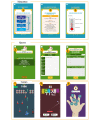Comparing Effectiveness Between a Mobile App Program and Traditional Cognitive Behavior Therapy in Obsessive-Compulsive Disorder: Evaluation Study
- PMID: 33464208
- PMCID: PMC7854038
- DOI: 10.2196/23778
Comparing Effectiveness Between a Mobile App Program and Traditional Cognitive Behavior Therapy in Obsessive-Compulsive Disorder: Evaluation Study
Abstract
Background: This study proposes a digital program for the treatment of mental illness that could increase motivation and improve learning outcomes for patients. Several studies have already applied this method by using an exposure and response prevention-inspired serious game to treat patients with obsessive-compulsive disorder (OCD).
Objective: We hypothesized that a mobile cognitive behavior therapy (CBT) program would be as effective in treating OCD as traditional offline CBT. In addition, the treatment efficacy in response to mobile CBT for OCD might be associated with increased brain activity within the cortico-striato-thalamo-cortical (CSTC) tract.
Methods: The digital CBT treatment program for OCD, OCfree, consists of 6 education sessions, 10 quests, and 7 casual games. Information was gathered from 27 patients with OCD (15 offline CBT and 12 OCfree CBT). During the 6-week intervention period, changes in clinical symptoms and brain function activity were analyzed.
Results: There was no significant difference in the change in OCD symptoms and depressive symptoms between the two groups. However, the OCfree group showed greater improvement in anxiety symptoms compared to the offline CBT group. Both offline CBT and OCfree CBT increased the functional connectivity within the CSTC tract in all patients with OCD. However, CBT using OCfree showed greater changes in brain connectivity within the thalamus and insula, compared to offline CBT.
Conclusions: OCfree, an OCD treatment app program, was effective in the treatment of drug-naïve patients with OCD. The treatment effects of OCfree are associated with increased brain connectivity within the CSTC tract. Multisensory stimulation by education, quests, and games in OCfree increases the activity within the thalamus and insula in patients with OCD.
Keywords: behavior therapy; cognitive; cognitive behavior therapy; cortico-striato-thalamo-cortical tract; exposure and response prevention; functional connectivity; mental illness; obsessive-compulsive disorder; prevention.
©Hyunchan Hwang, Sujin Bae, Ji Sun Hong, Doug Hyun Han. Originally published in JMIR Mental Health (http://mental.jmir.org), 19.01.2021.
Conflict of interest statement
Conflicts of Interest: None declared.
Figures







Similar articles
-
Investigation of a Mobile "Serious Game" in the Treatment of Obsessive-Compulsive Disorder: A Pilot Study.Games Health J. 2018 Oct;7(5):317-326. doi: 10.1089/g4h.2017.0158. Epub 2018 Aug 21. Games Health J. 2018. PMID: 30129775
-
Functional Connectivity Changes in Obsessive-Compulsive Disorder Correspond to Interference Control and Obsessions Severity.Front Neurol. 2020 Aug 20;11:568. doi: 10.3389/fneur.2020.00568. eCollection 2020. Front Neurol. 2020. PMID: 32973642 Free PMC article.
-
Abnormalities within and beyond the cortico-striato-thalamo-cortical circuitry in medication-free patients with OCD revealed by the fractional amplitude of low-frequency fluctuations and resting-state functional connectivity.Neurosci Lett. 2019 Nov 1;712:134449. doi: 10.1016/j.neulet.2019.134449. Epub 2019 Aug 27. Neurosci Lett. 2019. PMID: 31470044
-
Role of the dorsal anterior cingulate cortex in obsessive-compulsive disorder: converging evidence from cognitive neuroscience and psychiatric neurosurgery.J Neurosurg. 2017 Jan;126(1):132-147. doi: 10.3171/2016.1.JNS15601. Epub 2016 Apr 1. J Neurosurg. 2017. PMID: 27035167
-
Exploring genetic and epigenetic markers for predicting or monitoring response to cognitive-behavioral therapy in obsessive-compulsive disorder: A systematic review.Neurosci Biobehav Rev. 2025 Jul;174:106192. doi: 10.1016/j.neubiorev.2025.106192. Epub 2025 May 3. Neurosci Biobehav Rev. 2025. PMID: 40324706 Review.
Cited by
-
Benefits and barriers associated with using cognitive-behavioral therapy to treat obsessive-compulsive disorder: a narrative review.Front Psychiatry. 2025 Jul 28;16:1593384. doi: 10.3389/fpsyt.2025.1593384. eCollection 2025. Front Psychiatry. 2025. PMID: 40791208 Free PMC article. Review.
-
Gaming My Way to Recovery: A Systematic Scoping Review of Digital Game Interventions for Young People's Mental Health Treatment and Promotion.Front Digit Health. 2022 Apr 7;4:814248. doi: 10.3389/fdgth.2022.814248. eCollection 2022. Front Digit Health. 2022. PMID: 35465647 Free PMC article.
-
The Effectiveness of Serious Games for Alleviating Depression: Systematic Review and Meta-analysis.JMIR Serious Games. 2022 Jan 14;10(1):e32331. doi: 10.2196/32331. JMIR Serious Games. 2022. PMID: 35029530 Free PMC article. Review.
-
Psychotherapies and digital interventions for OCD in adults: What do we know, what do we need still to explore?Compr Psychiatry. 2023 Jan;120:152357. doi: 10.1016/j.comppsych.2022.152357. Epub 2022 Nov 15. Compr Psychiatry. 2023. PMID: 36410261 Free PMC article. Review.
-
Evaluation of the impact of a digital care navigator on increasing patient registration with digital mental health interventions in routine care.Internet Interv. 2024 Sep 17;38:100777. doi: 10.1016/j.invent.2024.100777. eCollection 2024 Dec. Internet Interv. 2024. PMID: 39410952 Free PMC article.
References
-
- Stein Dan J, Costa Daniel L C, Lochner Christine, Miguel Euripedes C, Reddy Y C Janardhan, Shavitt Roseli G, van den Heuvel Odile A, Simpson H Blair. Obsessive-compulsive disorder. Nat Rev Dis Primers. 2019 Aug 01;5(1):52. doi: 10.1038/s41572-019-0102-3. http://europepmc.org/abstract/MED/31371720 - DOI - PMC - PubMed
LinkOut - more resources
Full Text Sources
Other Literature Sources

